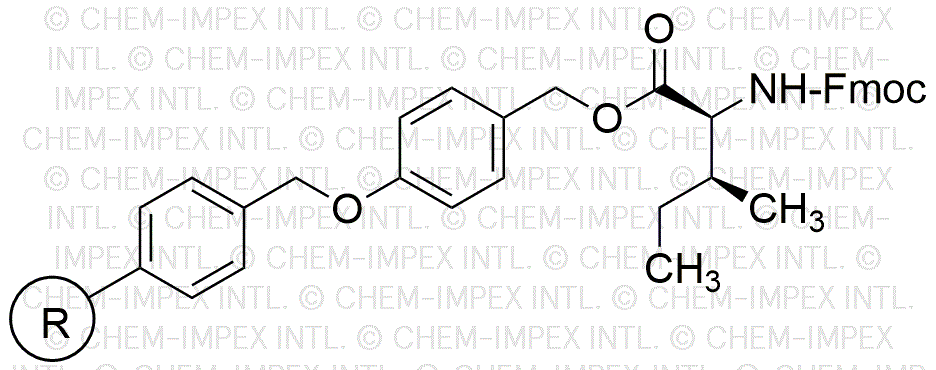Fmoc-L-isoleucine 4-alkoxybenzyl alcohol is widely utilized in research focused on:
- Peptide Synthesis: This compound serves as a protecting group in the synthesis of peptides, allowing for selective reactions and enhancing the yield of desired products.
- Drug Development: It plays a crucial role in the design of peptide-based drugs, particularly in optimizing their stability and bioactivity for therapeutic applications.
- Bioconjugation: The compound is used in bioconjugation processes, facilitating the attachment of biomolecules to surfaces or other molecules, which is essential in creating targeted drug delivery systems.
- Research in Cancer Therapy: It is explored in the development of novel anticancer agents, leveraging its ability to modify peptide structures for improved efficacy against cancer cells.
- Material Science: The compound is applied in creating functional materials, such as hydrogels, which can be utilized in drug delivery and tissue engineering applications.
Informations générales
Propriétés
Sécurité et réglementation
Applications
Fmoc-L-isoleucine 4-alkoxybenzyl alcohol is widely utilized in research focused on:
- Peptide Synthesis: This compound serves as a protecting group in the synthesis of peptides, allowing for selective reactions and enhancing the yield of desired products.
- Drug Development: It plays a crucial role in the design of peptide-based drugs, particularly in optimizing their stability and bioactivity for therapeutic applications.
- Bioconjugation: The compound is used in bioconjugation processes, facilitating the attachment of biomolecules to surfaces or other molecules, which is essential in creating targeted drug delivery systems.
- Research in Cancer Therapy: It is explored in the development of novel anticancer agents, leveraging its ability to modify peptide structures for improved efficacy against cancer cells.
- Material Science: The compound is applied in creating functional materials, such as hydrogels, which can be utilized in drug delivery and tissue engineering applications.
Documents
Fiches de données de sécurité (FDS)
La FDS fournit des informations de sécurité complètes sur la manipulation, le stockage et l’élimination du produit.
Spécifications du produit (PS)
Le PS fournit une description complète des propriétés du produit, notamment sa composition chimique, son état physique, sa pureté et les exigences de stockage. Il détaille également les plages de qualité acceptables et les applications prévues du produit.
Certificats d'analyse (COA)
Recherchez des certificats d'analyse (COA) en saisissant le numéro de lot du produit. Les numéros de lot et de lot se trouvent sur l'étiquette d'un produit, après les mots « Lot » ou « Lot de fabrication ».
Numéro de catalogue
Numéro de lot/série
Certificats d'origine (COO)
Ce certificat d'exploitation confirme le pays dans lequel le produit a été fabriqué, et détaille également les matériaux et composants utilisés et s'il est issu de sources naturelles, synthétiques ou autres sources spécifiques. Ce certificat peut être requis pour les douanes, le commerce et la conformité réglementaire.
Numéro de catalogue
Numéro de lot/série
Fiches de données de sécurité (FDS)
La FDS fournit des informations de sécurité complètes sur la manipulation, le stockage et l’élimination du produit.
DownloadSpécifications du produit (PS)
Le PS fournit une description complète des propriétés du produit, notamment sa composition chimique, son état physique, sa pureté et les exigences de stockage. Il détaille également les plages de qualité acceptables et les applications prévues du produit.
DownloadCertificats d'analyse (COA)
Recherchez des certificats d'analyse (COA) en saisissant le numéro de lot du produit. Les numéros de lot et de lot se trouvent sur l'étiquette d'un produit, après les mots « Lot » ou « Lot de fabrication ».
Numéro de catalogue
Numéro de lot/série
Certificats d'origine (COO)
Ce certificat d'exploitation confirme le pays dans lequel le produit a été fabriqué, et détaille également les matériaux et composants utilisés et s'il est issu de sources naturelles, synthétiques ou autres sources spécifiques. Ce certificat peut être requis pour les douanes, le commerce et la conformité réglementaire.

